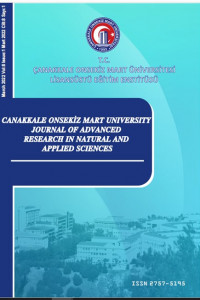Abstract
Supporting Institution
Sakarya Üniversitesi
Thanks
Mümtaz İpek
References
- Krizhevsky, A., et al. 2012. Imagenet Classification With Deep Convolutional Neural Networks. Advances in Neural Information Processing Systems 25 (NIPS 2012), sf: 1097-1105.Arslan, B. (2019).
- Bingol et al., Gold price prediction in times of 0inancial and geopolitical uncertainty: A machine learning approach, 2020.
- Sima Siami Namin 1, Akbar Siami Namin, Forecasting economic and financial time series: arima vs. lstm, 2018
- Özlem Alpay, LSTM Mimarisi Kullanarak USD/TRY Fiyat Tahmini, 2020
- D. Jakhar and I. Kaur., 2019. Artificial intelligence, machine learning and deep learning: definitions and differences.
- Mehryar, Mohri, A. R. 2012. Foundations of Machine Learning. Cambridge, UNITED STATES, MIT Press.
- Stuart J. Russell, Peter Norvig. 2010. Artificial Intelligence: A Modern Approach
- Şeker Abdulkadir, Banu DİRİ, Hasan Hüseyin BALIK. 2017. Derin Öğrenme Yöntemleri ve Uygulamaları Hakkında Bir İnceleme.
- Şişmanoğlu Gözde, Furkan Koçer, Mehmet Ali Önde, Özgür Koray Şahingöz. 2019. Derin Öğrenme Yöntemleri İle Borsada Fiyat Tahmini.
- Box, G.E.P., Jenkins, G. (1970). Time series analysis, forecasting and control, Holden-day, San Francisco, CA.
- Kingma, D.P., Ba, J. (2014). Adam: A method stochastic optimization.
Abstract
In this study, financial prediction models have been developed over the silver / ounce parity using deep learning architectures. LSTM and ARIMA architectures, which are deep learning algorithms, are used. By loading the train-ing and test data into the established algorithms, the system was learned and a graphical estimation was requested on the silver / ounce parity for the next 10 days.
Written algorithms can produce different results each time they are run. However, in the graphs we have taken as an example, the graph created with the ARIMA architecture has produced a more realistic result by specifying a range and making an upward forecast. The prediction chart we obtained with the LSTM architecture did not create a much decrease or upward forecast. However, as a feature of the LSTM algorithm, it clearly predicted the daily closing values, and did not specify an estimation as a range and direction as in the study with the ARIMA architec-ture. It should not be forgotten that these algorithms are dynamic and can give different results in predictions even when they are run with the same data.
According to the results obtained in the research, although the LSTM architecture clearly stated the daily closing values as numbers, the estimation study made with the ARIMA architecture produced a result closer to the graph in terms of both interval and direction.
References
- Krizhevsky, A., et al. 2012. Imagenet Classification With Deep Convolutional Neural Networks. Advances in Neural Information Processing Systems 25 (NIPS 2012), sf: 1097-1105.Arslan, B. (2019).
- Bingol et al., Gold price prediction in times of 0inancial and geopolitical uncertainty: A machine learning approach, 2020.
- Sima Siami Namin 1, Akbar Siami Namin, Forecasting economic and financial time series: arima vs. lstm, 2018
- Özlem Alpay, LSTM Mimarisi Kullanarak USD/TRY Fiyat Tahmini, 2020
- D. Jakhar and I. Kaur., 2019. Artificial intelligence, machine learning and deep learning: definitions and differences.
- Mehryar, Mohri, A. R. 2012. Foundations of Machine Learning. Cambridge, UNITED STATES, MIT Press.
- Stuart J. Russell, Peter Norvig. 2010. Artificial Intelligence: A Modern Approach
- Şeker Abdulkadir, Banu DİRİ, Hasan Hüseyin BALIK. 2017. Derin Öğrenme Yöntemleri ve Uygulamaları Hakkında Bir İnceleme.
- Şişmanoğlu Gözde, Furkan Koçer, Mehmet Ali Önde, Özgür Koray Şahingöz. 2019. Derin Öğrenme Yöntemleri İle Borsada Fiyat Tahmini.
- Box, G.E.P., Jenkins, G. (1970). Time series analysis, forecasting and control, Holden-day, San Francisco, CA.
- Kingma, D.P., Ba, J. (2014). Adam: A method stochastic optimization.
Details
| Primary Language | English |
|---|---|
| Subjects | Computer Software |
| Journal Section | Research Article |
| Authors | |
| Early Pub Date | March 10, 2022 |
| Publication Date | March 10, 2022 |
| Submission Date | August 5, 2021 |
| Published in Issue | Year 2022 Volume: 8 Issue: 1 |


